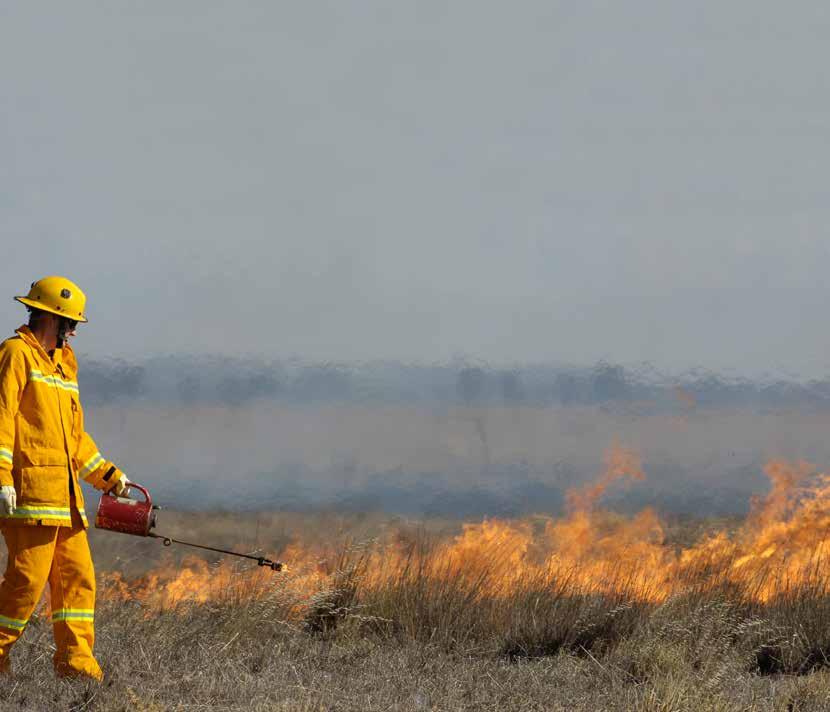
69 minute read
Members Online gets a makeover
How best to burn the bush
New research into the complexities of prescribed burning across Australian landscapes is supporting critical decisions about how and where to use fire to protect communities. With no one-size-fits-all approach to prescribed burning, strategies must be tailored to different environments and budgets. Drawing on cutting-edge science, the Prescribed Burning Atlas is a website designed specifically to assist and inform prescribed burning strategies. Using the Atlas, land and fire management departments can tailor their approaches in ways that best reduce bushfire risk in their local area and within available budgets. The Atlas was developed through the Bushfire and Natural Hazards CRC in partnership with the University of Wollongong, the University of Melbourne and Western Sydney University. While developing the Atlas, researchers used case study areas to measure the impacts of different prescribed burning strategies on various landscape types across Australia. One of these case study areas was East Central Victoria. You can now use the Atlas to look at how various factors, such as terrain, weather and climate change, will impact on different prescribed burning strategies in that region – including comparing the costs of different options and their effect on reducing the likelihood of life loss, property loss and landscape damage. Importantly, the Atlas can also show the likely financial costs of different strategies, and the point at which spending more money on prescribed burning does not have any measurable effect on reducing the bushfire risk. In addition to East Central Victoria, the Atlas covers 12 areas across NSW, ACT, Victoria, Tasmania, South Australia and Queensland, comprising different types of landscapes, including temperate forests, grasslands, savannas, deserts, woodlands and scrub. You can learn more about the research behind the Atlas by visiting bnhcrc.com.au/research/ riskmitigationsolutions or you can access the Atlas today at https://prescribedburnatlas.science/.
Advertisement
STORY BETHANY PATCH
New intranet and website coming soon
Volunteers and staff will soon be able to customise the CFA intranet homepage with links to the specific applications and information they need to carry out their roles. Subject matter experts will also be able to manage their own content on the website, to help ensure information is up to date, using a new content management system (CMS). All CFA’s websites are currently undergoing major overhauls with redesigns of the main public site, the News and Media site, and Members Online (previously known as CFA Online/Brigades Online). The sites will be relaunched on the new CMS over winter and will give volunteers, staff, and the wider community easier access to relevant, up-to-date information and more control over the information that’s important to them. On Members Online, an improved menu structure and search functionality will make it easier for members to find relevant people and information. All CFA members will be able to share news, photos and videos in the Members Online news section and several paper-based forms will be replaced with online forms. On the public website, visitors will be able to set their location and get localised information about the Fire Danger Period, Fire Danger Ratings, bushfire risk, the nearest neighbourhood safer places and any CFA events happening nearby. Visitors will also be alerted to any issues of concern across the state with automated links to specific warnings on the VicEmergency website. Member Communications and Engagement Manager Bradley Thomas said implementing the new CMS is the first phase in improving CFA’s websites. “This is not a ‘set and forget’,” Bradley said. “The new CMS will make it easier for the CFA digital team to continuously improve the content and usability of CFA’s websites, based on feedback from volunteers, staff, and the community.” The new sites have been developed in consultation with stakeholders from across CFA including volunteers, district and region staff and various CFA directorates.
LMC Lessons Management Centre
lessons-management-centre@cfa.vic.gov.au
Why after action reviews are important
An after action review (AAR) is a key component of postincident activities. The purpose of an AAR is to identify key observations, learning opportunities and good practice to ensure learning and improvement occurs within CFA. It’s vital to understand that an AAR is about improving performance and not about assigning blame. An AAR allows participants (either as individuals or as a group) to work through a series of questions that enables them to reflect on an experience to uncover lessons in a nonpunitive environment. The outcomes of AARs will inform the ongoing cycle of learning and improvement within CFA and the sector by validating and evaluating existing doctrine, arrangements, policy, procedure and incident/ emergency management application. The outcomes will provide evidence to inform a range of activities including training, exercising, briefings and numerous products. Throughout CFA many AARs are conducted all year round and we encourage all CFA members to participate. Ask your brigade, district, and region what they are planning. AAR activities can be face-toface, online surveys or individual input, so if you have something to share please put your hand up or contact the Lessons Management Centre for information and guidance: Lessons-Management-Centre@cfa.vic.gov. au
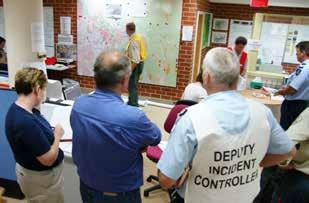
1. What was planned? 2. What actually happened? 3. What worked well? 4. What would we do differently next time?
Personal experience of an after action review
It was the Queen’s Birthday Weekend 2020 when the pager went off notifying of a structure fire in north-east Victoria with the possibility of occupants being trapped. The incident was not without its challenges and I encourage you to read the case study on the following pages if you’d like more detail about the incident. In the days after the incident, I reflected on what had occurred and what I had done or could have done differently that may have changed the outcome. What surprised me, was that I couldn’t think of anything that anyone could have done differently to change the outcome. I struggled with this a little because it was hard to accept there wasn’t a lesson to learn from attending a fire of such significance. This thought pattern led me to discuss the possibility of conducting a formal AAR with the group officer and then contacted the CFA Lessons Management Centre (LMC), both of whom helped us through the process in a changing COVID-19 environment. After all the information had been collated, clear themes appeared. With the assistance of LMC a report was prepared that identified the key lessons. Actions were then developed and agreed upon by key people from the brigade, group and district. Some key actions from the AAR have been addressed to ensure that the lessons identified are learned. For example, the response tables for assignment areas for my brigade’s response areas have been reviewed and updated; a review of BA support capability is underway and a case study has been prepared by LMC. There are also further actions identified that will be progressed at brigade, group and district level, with at least two recommendations being passed onto CFA HQ for action. I can see the significant benefits to CFA in the AAR process. It takes work and resources, but the benefits will be long lasting throughout the organisation if done properly. You will be surprised what you can learn and what improvements you can make. I know I have learned a lot more than I expected. I hope that many more brigades will follow a similar process so that we can share what we learn from our experiences. First lieutenant from a north-east brigade
case study
Summary
In June 2020 at 11.30pm CFA was called to a structure fire. There were reports of multiple occupants who were both unaccounted for and injured. The incident was complex to manage, particularly in the early stages, because of the remote location and the number of occupants.
Incident overview
Resourcing plans were established based on the information provided by VicFire and the distance of the fire from the primary brigade. There was an expectation that the structure would be almost fully alight by the time crews arrived and that there may be people trapped inside. It was also considered that water supply and sufficient breathing apparatus (BA) support could be additional problems. A local brigade’s pumper was deployed first to ensure some level of BA capability and plans were established to request further resources to provide both water and BA support well in advance. The initial plan had two components, the rescue and support of the residents and the suppression of the fire. This plan evolved to include sectorisation of the incident including water, suppression and BA, and the setup of an incident emergency management team (IEMT) consisting of CFA, Ambulance Victoria (AV) and Victoria Police representatives. There was also an aim to reduce the impact of this incident on the members in attendance. Prior to arrival, additional resources were requested, including 10 tankers, two pumpers and BA support from district headquarters. Only at this point was a tanker dispatched from the brigade that was geographically closest to the fire. When they arrived at the incident, crews could see the building was fully alight and showing signs of structural collapse. However, the initial plan remained applicable. Initial reports of both injured and missing residents prompted further investigation including a size-up and search around the property, because there were no people at the front of the house. At the rear of the property, firefighters found four adults and five children with injuries that included second or third-degree burns, smoke inhalation, lacerations and severe shock. Neighbours added to the confusion about how many people were staying at the house and the number of people missing. Despite this, one CFA member was able to gather information from an occupant regarding the people who were unaccounted for and confirmed there were 13 people in the house when the fire started. First-aid was priority and AV was informed of the number of patients so it could increase the number of resources sent to the scene. As the rescue began, it became clear that it would not be possible because of the intensity of the fire. Firefighters in BA were unable to venture any further than one metre inside. Instead, efforts were focused on RECEO – rescue, exposures, containment, extinguishment and overhaul, to prioritise tasks. The first priority were injured residents. At this point, it became apparent that two key situations needed to be managed: the actual firefight and mass casualties. Overall incident control was seamlessly passed to a local brigade’s 1st lieutenant for the firefight operations and the group officer managed the casualty sector with AV. Crews began working effectively and cohesively to supply water to the pumper and a water sector was established. In addition, gas cylinders were being cooled as they vented. There was a problem ensuring adequate water supply levels – at one point crews ran out of water until further tankers arrived to relay water to the pumper. Also, the number of trucks on the road made it difficult for the trucks to manoeuvre and made it hard for AV to access the site, so a decision was made to open a paddock to allow tankers to enter and turn around. A BA crew arrived at the same time as the district HQ brigade FCV and a BA sector was set up. However, it was never fully established, though BA and cylinders were obtained from tankers ferrying water. After the incident was deemed under control, members were briefed about the likelihood of fatalities because two people were missing. Everyone was told that unless there was an absolute need, members should not go near the structure. A local brigade’s catering truck and peer support were requested to attend. Not long after this briefing, the missing occupants were found inside the house and the police were notified. There was a deliberate effort to keep the number of members near the structure to a minimum, except those undertaking overhaul or other essential activities. The police set up a crime scene logged all members going in and out of the area. After a discussion between CFA members and the police about disrupting the scene, it was decided that some of the hotspots in the structure would be left smouldering until daylight when the arson squad and fire investigators were on scene. In the morning, the fire investigator noticed flaring of the hotspots and requested a brigade. When the fire was completely extinguished and forensics were finished, the bodies were removed and remaining crews returned to the station.
What went well
Size-up and gathering information: A 360-degree size-up was beneficial in this incident in identifying multiple factors including scene access, fire activity and casualties. In addition, the initial actions of firefighters to collect information such as the details of those who were unaccounted for and communicate it up the chain of command for effective use in incident management was invaluable.
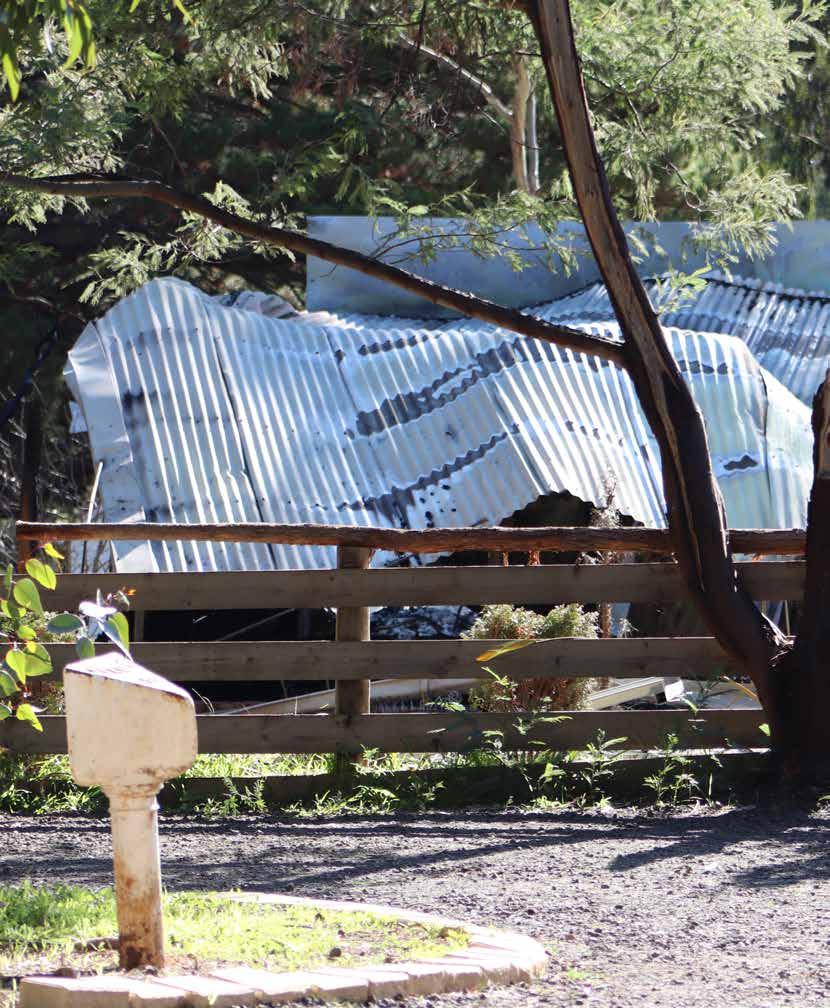

PHOTOD: COURTESY OF NORTH CENTRAL REVIEW
Operational decision-making: Rapid yet wellconsidered and adaptive incident management and firefighter decision-making in challenging circumstances played a vital role in controlling this fire and the management of the casualties. This included seamless transfer of control to match incident complexity and experience, and clearlydefined incident priorities using SPADRA and RECEO for the protection and preservation of life. Early resource request: This incident highlighted the importance of early requests for additional resources such as more pumpers, tankers, BA support, catering and other vehicles to enable effective incident management, crew support and fire suppression. The early request for resources reduced delays in combating this emergency. Member wellbeing: This incident also highlighted the importance of prioritising member wellbeing and managing it effectively. Steps were taken to limit exposure to members on scene and CFA Peer Support was notified and attended the scene. Peers continued to provide support to firefighters after the incident. During the debriefing and follow-up, there was a focus on members’ welfare. Local knowledge: Local knowledge was described as instrumental in this incident because it allowed for the rapid identification of nearby helicopter landing sites for AV and the police. This allowed helicopters to land safely and closer to the scene than originally planned, which reduced the time it took to transfer casualties.
Lessons identified
Computer-aided dispatch (CAD) resource response: It was identified that the nearest support brigade was not notified of the call in the first dispatch. CAD resource response tables require regular review by brigades, groups and district staff to ensure they are up to date and provide appropriate resource response. Managing tanker water supply: Planning and task allocation for incoming additional resources such as tankers is important. In this incident, the nature of the scene led to tanker congestion when queuing to supply water to the pumpers. There was a need for personnel to control and manage the tanker water supply, and when this was done there was better coordination and truck movement. Incident controllers could also consider allocating a second fireground channel to help manage resources. Lighting: The incident took place at night and lighting was a problem because there were inadequate lighting resources available locally. Wherever possible brigades should ensure they have sufficient lighting available or request additional resources to ensure the scene remains safe for all members. It would also be worthwhile for brigades to improve the scene lighting capabilities on board their trucks, as this would have been used early in the incident.
Conclusion
This incident was challenging because of its location, the number of casualties, the number of people involved, the rescue and the time of the fire. Adaptable crews quickly gathered information, maintained a focus on the priorities, carried out an accurate size-up and used SPADRA and RECEO. They also requested additional resources early on to avoid delays in suppressing the fire. The case study was developed by North East, brigade, group and region members who responded and participated in the incident after action review and wanted to share their experience. If you have any lessons to share, email Lessons-ManagementCentre@cfa.vic.gov.au.
Structural collapse
During a fire, a building’s load-bearing structural elements, such as walls, may be damaged. In turn, this can exert unpredictable stresses on the rest of the structure, leading to a collapse. This is a significant risk for firefighters. Many building structures now use lightweight materials and construction techniques in the form of engineered floor joists and roof trusses. These structural members use nail plates and pressed steel open webs designed to ‘bite’ into the outside of the timber. Although the depth of the bite can vary, it can be as little as 5mm to 10mm which is quickly compromised if the timber member is involved in fire. The lightweight steel used to create the open web is also far more susceptible to heat and subsequent failure. If you see any movement, sagging, cracking, spalling or any other signs a structure might be about to collapse, withdraw immediately to a safe location. Here are signs that a structure may be about to collapse. • Cracks appearing in brickwork: Smoke (even just a small amount) seeping through cracks or mortar joints could indicate a wall’s form is failing. Cracks may appear at high levels or corners.
• Concave ceilings: Excessive amounts of water or foam directed into the ceiling area can weaken plaster, and a collapsing ceiling plaster can cause the whole ceiling to break down. • Concave floors: When water is applied to a fire, it may accumulate or be absorbed in the floor. This can increase the weight of the load and cause the floor to sag and then collapse. If possible, avoid directing water onto absorbent materials such as wool, cotton bales, wood pulp and paper.
• Walls out of alignment: If walls appear out of line or begin to bulge, move away immediately. They may collapse with little warning, particularly in buildings with a tilt slab construction.
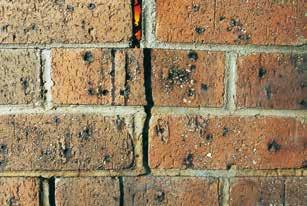
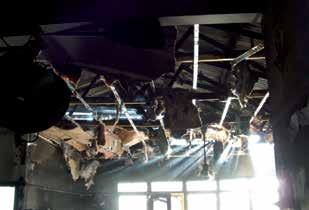


• Unprotected steel distorting: If steel framing starts to expand, twist or distort it may cause other parts of the structure to collapse.
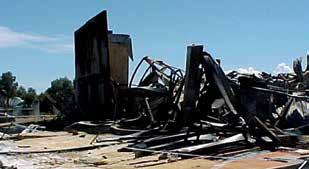
• Movement in a floor or roof: If a floor subjected to a fire below is springy to walk on, it may collapse. The beams or joists supporting the floor may have been weakened by the fire. • Prolonged burning: Fires burning over a long period of time will breach and weaken the load-bearing elements of a structure which could lead to collapse. • Loud noises: If you hear loud noises and frequent cracking sounds during an intense fire, collapse may be imminent. The cracking sounds could indicate internal structural components are being weakened. • Sparks and embers: A stream of sparks and embers rising in a plume may indicate parts of the internal structure (such as floors) have collapsed. Personnel must immediately withdraw to a safe location if they see any movement, sagging, cracking, spalling or any other signs a structure might be about to collapse.
case study
Summary
Three CFA brigades had the opportunity to conduct a live burn exercise of a derelict house in 2019 following careful planning and authorisation. The exercise was an important learning opportunity for CFA firefighters, and Stanhope Fire Brigade identified lessons for future training and response.
Incident overview
In early 2018, the Stanhope brigade captain was approached by a new landowner in the Stanhope area to find out whether the local brigade could remove a derelict house so that a new home could be built. The owners were advised that the brigade could burn the building as a training exercise, however they would need to follow SOP 6.03 Derelict Houses – Burning Of, which required complex approval. The brigade captain established a burn plan including SMEACs and risk assessment. Overall, the process took over 12 months and many hours of volunteered time. In the lead-up to the event, there were significant changes to operational staff at the district, which meant many people had to be briefed about the exercise before the final sign-off could be provided. During the planning stages, it was decided that if the fire was initially lit on the couch in the lounge room at the south end, it would burn slowly for about three hours against the predicted wind, allowing crews wearing breathing apparatus (BA) time to gain inside experience and understanding of internal fire behaviour. After the planning was complete and approvals were received, Powercor attended the site to relocate the underground power before the burn. Also, a registered asbestos remover attended to remove all asbestos at the expense of the property owner. In August 2019, all those taking part met at Stanhope Fire Station for a briefing before going to the property. Stanhope pumper and tanker were on scene, along with Girgarre brigade’s FCV and tanker and Echuca brigade’s support vehicle. About 20 CFA members from the three brigades were involved in the exercise. In addition, a commander from District 20 attended to assist in training members in forcible entry, gas cooling, thermal imaging camera operation and BA search and rescue. Further training was also undertaken in BA skills maintenance, hose relaying and advanced pumping in a rural setting. The lounge room of the house was lit by the property owner at about 11am. The fire took hold quicker than expected because of strong winds and a wind tunnel along the hallway where a door had been removed by the asbestos removers. As the fire took hold, it was clear from the amount of black smoke coming from the weatherboards in the pitch of the roof that the roof was going to collapse soon. The property was fully alight in 13 minutes and the roof collapsed after 16 minutes. After the house had burned to the ground, the owners used farm machinery to push the remains up to ensure a clean burn with very little rubble left to be cleared up.
What worked well

Planning: Although it was time-consuming, with many stakeholders needing to be regularly briefed, the planning was vital to the success of the exercise. It was also a rare opportunity to understand the amount of work involved in such an exercise. Training opportunities: The exercise provided invaluable training opportunities to members in a controlled environment, including truck placement, hose set-ups, pumping, how to set up, how to communicate and understanding fire behaviour. Teamwork: Involving neighbouring brigades in the exercise allowed members of Stanhope brigade to work with people who would support them in reallife incidents, and for brigades to share knowledge, techniques and skills. Echuca support: The exercise enabled all members to work with a new vehicle for the first time, the Echuca support, and understand its capabilities regarding rehab and BA control points, and find out what support it can provide in a going incident. Recognising the risks of structural collapse: The crew at the site of the training burn recognised the changes in fire behaviour and resulting conditions. The change to the pitch of the roof provided crews with clear evidence that structural collapse was likely to occur. Effective hazard identification, such as structural collapse, allows for appropriate safety measures to be implemented to ensure firefighters remain safe. Firefighter safety at any training or emergency incident is underpinned by continuous dynamic risk assessment and a safe person approach by all personnel.
Lessons identified
Prior training: The value gained from an exercise like this would be improved by ensuring members have undertaken additional prior training in internal fire behaviour so a greater focus can be placed on furthering existing skills and higher-level skills.

PHOTOS: SUPPLIED BY STANHOPE FIRE BRIGADE
More exercises: Brigades should actively seek to identify opportunities in their communities to learn about structure fire response in a safe, controlled environment. Without the generous offer from a member of the community and the continued support of district staff, this opportunity would not have been possible. There was some critical feedback on social media platforms which was challenging to manage, however the brigade gained valuable training insight that negated any unwarranted criticism. By increasing the number of these exercises, more brigades would develop skills in a controlled environment. Structure fire behaviour – flow path: Strong winds can increase the intensity, speed and direction of a fire, especially when windows are broken or, like in this exercise, a door had been removed. In a structure fire, convection currents convey the hot gases produced by combustion up stairwells and through openings, spreading the fire to the upper levels or laterally through the structure. Cooler air moving in to replace the hot gases rising from the fire helps to accelerate the burning by supplying the fire with additional oxygen. Prevailing weather conditions can also have an impact on fire spread in a structure.
Conclusion
This exercise was an invaluable experience for the brigades involved to train together and for less experienced members to experience a going structure fire. Furthermore, this fire highlighted to the brigade members the intensity of structure fires, particularly older weatherboard homes, and how little time you have before the structure begins to collapse. To develop skills and knowledge all firefighters should be encouraged to undertake training exercises that reflect real-life incidents. CFA firefighters are encouraged to review and continuously improve their knowledge of fire behaviour
Brigade discussion points
After reading this case study, consider the actions you would take. • How would you undertake a risk assessment?
Consider what your risk assessment would be during the planning stages of a structure fire training burn.
Then consider what your dynamic risk assessment might identify in rapidly changing conditions during the burn. How do you respond? • What resources do you think are required at a scene like this one? Are there any specialist skills required? • Discuss with your brigade heat transfer in structure fires. How does the change in conditions affect your initial plan and what changes do you need to make to the original tactics? Remember safety first. • Discuss the actions you would need to implement when confronted with the risk of structural collapse.
What role does the safety officer perform here?
Consider establishing a collapse zone, vehicle positioning, issuing a red flag warning and what changes you need to make in your firefighting strategy. This case study was developed by Stanhope Fire Brigade who wished to share their experience. Thanks to all the crews who participated in this exercise. If you have any lessons to share email LessonsManagement-Centre@cfa.vic.gov.au
References
Structural Firefighting Learning Manual: repository. cfals.info/content/structural_firefighting SOP6.03 Derelict Structures – Burning of: members.cfa.vic.gov.au/mycfa/ Show?pageId=displayDoc&docId=002797
Understanding why people ‘wait and see’
When there’s a high risk of bushfire, the primary message to at-risk communities is to leave early – either the night before or early in the morning. But anecdotally we’ve known for some time that many people are likely to ‘wait and see’. To help emergency services’ personnel understand why people at threat from a bushfire delay their decision, the Knowledge and Evidence team collaborated on research projects to investigate ‘wait and see’ and the key factors influencing people’s decisions. The findings will help CFA members to tailor advice and support for residents in high risk areas.
Size of the ‘wait and see’ issue
The research literature shows that at least 25 per cent of residents delay their protective decision-making, and some studies report that between 45 to 60 per cent of respondents delay their protective decisions. The key conclusion to be drawn from the literature is that delay in protective action decision-making is the predominant response to bushfire threat in Australia. The major reason why waiting to see what happens is viewed as undesirable is that it’s associated with late and dangerous evacuation, increasing the likelihood of injury and fatalities or being caught in an undefendable shelter.

In the simplest terms, people believe that waiting and then leaving if threatened by bushfire is a safe strategy to improve the chance of simultaneously protecting their property and their personal safety. They choose to delay because they want to be safe from bushfire but don’t want their property to be vulnerable to threats such as falling embers which may be readily extinguished. They see delay as the best strategy because they believe the risk is limited because of low fire threat, expectation of survival, and warnings and protection from the fire services. To them, delaying also means less cost, disruption and inconvenience. People don’t tend to defer timely action due to indecision, but because delaying is inherent in their archetypal response to bushfire threat. Delaying reflects how they prioritise actions depending on their predominant archetypal attitudes and responses to bushfire. Women and men assess the costs and benefits of delay in a similar way. Women are willing to delay protective actions in the same way as men, though they appear to prefer to respond to risk sooner than men.
Implications for emergency services
With so many people delaying action for what they see as rational reasons, combined with the impact of delay on personal safety, bushfire safety policy and programs should better address the reasons for delay and offer solutions. Community bushfire safety policies and programs that take into account this predominant ‘wait and see’ behaviour are more likely to be effective than just requiring certain behaviours determined by emergency agencies. It’s essential that emergency agencies are more adaptable and responsive to individual and local differences and identify, assess and challenge the assumptions they have made in the past about individual and community needs and responses. Agencies need to better understand and take into account people’s needs and values including the archetypal behaviour that may be inherent in their decision to delay protective action. This would include changing people’s risk-reward assessments through more targeted: • information and warnings about bushfire risk and impact • information about property preparation to reduce vulnerability and enhance survivability • support for evacuation planning including preevent organisation and safe escape routes • development of sophisticated individualised evacuation triggers.
How CFA is using this research
The findings of this research are an important contribution to the social science literature on the vexed issue of ‘wait and see’. The evidence points to the need to destigmatise the decisions people make before and during bushfires, and for agencies to adapt their approaches to better take account of how people will continue to behave. To this end, CFA has been exploring ways in which bushfire archetypes can help us understand the needs and issues faced by individuals living in high bushfire risk areas. Archetypes are a lens that can be used to understand human behaviour and decision-making by grouping key characteristics together. In the context of bushfires, Dr Ken Strahan identified seven self-evacuation archetypes based on a variety of influencing factors including risk perception, stakeholder perceptions, the perceived effectiveness of preparedness actions, self-reliance, experience and intended response. Through a Safer Together-funded research project, it was possible to work with a range of key stakeholders at CFA and DELWP to start to devise ways to use the archetypes in community engagement and education approaches. There were also sub-projects exploring the potential for the archetypes to assist with predictive services and modelling of evacuation during bushfires and exploring the implications of the research for how we monitor and evaluate community safety programs.
Next steps
A video has been developed to communicate the key findings of the research to CFA members and other interested stakeholders. An initial key focus will be internal capability building around the archetypes and exploring ways the research can be used to enhance existing community safety programs or integrated into pilot initiatives. A range of opportunities exists to collaborate across CFA and with DELWP to use the findings to inform how we address the challenges we face in adapting our overall approach to better meet the needs of the people living in the communities we serve. This will require thinking outside the square, trying new things and learning from both the successes and failures. It doesn’t simply mean better targeting of information to communities. It requires more of a paradigm shift in our approaches. It’s an exciting prospect and one that builds on the latest evidence from social science research, combined with the collective knowledge and experience of CFA members, and collaboration with individuals and households living in Victoria. For more information email John Gilbert, Program Manager Research and Evaluation: j.gilbert@cfa.vic.gov.au Thanks to Woodend locals and CFA volunteers for helping to make this video.
STORY JOHN GILBERT
References
Strahan K, Gilbert, J. The Wait and See Literature: A Rapid Systematic Review. Fire 2021, 4(1), 4: https://doi. org/10.3390/fire4010004 Watch our video about how people behave when there’s a bushfire threat, and then think about the implications for how you engage with residents in your community: www.youtube.com/ watch?v=MTzx7G390_M&feature=youtu.be
s t
Between January 2016 and September 2020, CFA vehicles were involved in 194 reported collisions. The incidents share common contributing factors and we’ve outlined some important lessons to remind drivers how they can mitigate some of 12 I n c i d e n the risks. f r o 10
e
About 58 per cent of CFA vehicle incidents result from collision with a stationary vehicle or object. Other incident types included: 8 N umb • fire station engine bays and doors (30 accidents) 6 • CFA vehicle hit by another vehicle or object (22) 4 • moving vehicle hit by CFA vehicle (11) • CFA vehicle hit kangaroo (7) 2 • bogged vehicle (3) • equipment falling from vehicle (1) • impacted by fire (1) Several contributing factors were identified in these incidents including: failure to use a guide or spotter; no visual check by driver; unsecured equipment/hatches/doors; failure to conduct a mirror check; failure to apply the park 0 Time Periods 00:00 - 01:0001:00 - 02:0002:00 - 03:0004:00 - 05:0006:00 - 07:0007:00 - 08:0008:00 - 09:0009:00 - 10:0010:00 - 11:0011:00 - 12:0012:00 - 13:0013:00 - 14:0014:00 - 15:0015:00 - 16:0016:00 - 17:0017:00 - 18:0018:00 - 19:0019:00 - 20:0020:00 - 21:0021:00 - 22:0022:00 - 23:0023:00 - 00:00 brake; equipment failure; other drivers not maintaining situational awareness and causing a collision; road debris; time of the day; and poor weather conditions. The bar chart below shows the most common contributing factors to CFA vehicle collisions.
poor weather conditions
park brake not applied
no visual check
no mirror check
no guide
narrow road/tight turn
equipment/door/hatch on vehicle not secured properly
0 2 4 6 8 10 12 14 16
Of the reported collisions between 2016 and 2020, 70 per cent occurred between 9am and 8pm. This isn’t surprising given that most collisions happened while turning out to incidents, and more incidents occurred during the day. Also, there’s a higher volume of traffic during the day which increases the risk. Collisions involving a CFA vehicle travelling Code 3 were just as common as vehicles travelling Code 1, which shows that drivers need to focus at all times. The bar chart below shows the time the incidents occurred.
20
18
16
s t n e i d c I n f o r e umb N
14
12
10
8
6
4
2
0 00:00 - 01:0001:00 - 02:0002:00 - 03:0004:00 - 05:0006:00 - 07:0007:00 - 08:0008:00 - 09:0009:00 - 10:0010:00 - 11:0011:00 - 12:0012:00 - 13:0013:00 - 14:0014:00 - 15:0015:00 - 16:0016:00 - 17:0017:00 - 18:0018:00 - 19:0019:00 - 20:0020:00 - 21:0021:00 - 22:0022:00 - 23:0023:00 - 00:00
Secure equipment, hatches and doors: It’s important to check that all equipment is stowed correctly, and lockers, hatches and doors are securely shut. Ensure there is no risk of equipment falling from the vehicle or there are protruding objects that could cause a collision. Manoeuvre with a guide or spotter: There will be times when you need to manoeuvre a vehicle with the aid of a guide who uses recognised arm signals. The guide can see areas that are invisible to the driver and it’s better if there are two people watching for hazards. Don’t rely on shouted instructions in a noisy environment. The guide should position themselves either at the front or the rear of the vehicle, facing the vehicle and remaining visible to the driver at all times. Reversing a large vehicle is usually more difficult than controlling the same vehicle moving forward. Ensure the mirrors are correctly adjusted. If you have a person available who may not understand the hand signals to be used as a guide, you should use them as a spotter to help identify possible hazards and provide general guidance via voice instructions. Always use a guide or spotter if one is available.
Observations while moving: Be alert to the actions of other road users and to events taking place around you by regularly checking the road ahead and your mirror for other traffic and vehicle speed. Be aware of blind spots and check over the appropriate shoulder. Check the load and equipment through mirrors. Listen for unusual sounds. Maintain situational awareness and visually check the environment around you for hazards, such as partially lowered doors when leaving the fire station. Driving in wet weather conditions: Driving on wet roads, particularly after an extended hot spell, can create certain hazards. Visibility may be impeded and traction may be reduced especially if the vehicle has heavy lug (off-road) tyres. After a dry spell dust and oil on the road make it slippery. Skidding is also possible when you change direction suddenly, brake sharply or accelerate quickly. In these conditions and in rain consider your speed, reaction time, braking distance and visibility. Driving at night: To maximise vision at night, it’s important that the windscreen and rear window are clean on the inside and outside. When there are no oncoming vehicles, the driver should use high-beam lights to give visibility over a maximum distance. You must, of course, lower the beams (dip them) when there’s an oncoming vehicle.
Driver Front Suitable guide positions
Resources
For more information read CFA’s Drive Vehicles Under Operational Conditions manual on Members Online: repository.cfals.info/content/drive_vehicles_under_ operational_conditions
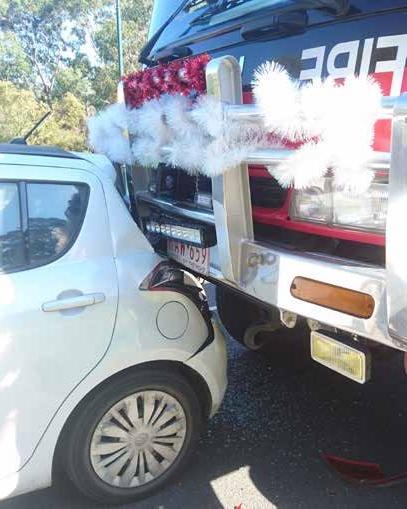

case study
Situation
A strike team was operating in a different part of the state from their home district. During a night shift, the strike team was divided into smaller groups so it could work over a distance of about 60 kilometres. One group consisting of two ultralight tankers (ULT) was tasked with meeting up with the strike team leader (STL) and a crew from DELWP to help extinguish spot over fires along a dozer track. To meet the STL and DELWP crew, they had to drive along a dozer track that had recently been dozed to create a fire break. The track soil was very fine and loose and could be described as bulldust in many areas. The track varied in gradient from flat to about 21 degrees. When the crews arrived at the meeting point late at night, the two ULTs parked behind the stationary STL’s field command vehicle, with the first ULT stopping about 15 metres from the FCV. The driver of the first ULT applied the park brake, left the engine running and exited the vehicle. At the same time, a member of the STL’s FCV was walking around the vehicle to adjust the work/scene lights. While walking around the rear of the FCV, he noticed the first ULT rolling towards him. He was struck between the two vehicles and thrown out to the side. First-aid was given at the scene for a leg puncture and then the member received additional first-aid at the division command (DivCom) before being transported to hospital. He was released the following day after having several stitches in the leg wound.
Contributing factors
In most collisions there are a series of contributing factors that result in the incident. This incident involved the following.
Logbook In the days leading up to the incident, several people from different districts had driven the ULT. One of these drivers made an entry in the logbook that stated ‘handbrake’. There was no further explanation, but the team investigating the incident assumed the entry meant the handbrake may have been faulty. The investigation team couldn’t determine whether the fault was reported and who it was reported to. As the strike team was operating from a DivCom and not a staging area, there was no district mechanical officer present. The vehicle logbook was not checked at the start of the shift. Unfamiliar vehicle and terrain The crews involved in the strike team were operating in terrain that differed from their home district. They were also operating in vehicles that belonged to other brigades. Operating in an unfamiliar environment, especially at night, can present some challenges. At night gradients don’t look as steep as during the day, so it’s important for drivers and crew leaders to monitor local conditions and be aware of and adjust to the driving environment. Vehicles have different park brake operating systems and drivers can’t be expected to know all of them. In this case, the ULT is based on a Toyota Landcruiser ute. The investigation team spoke to many people who regularly drive Landcruisers and all stated that it’s well known that the park brake must be fully applied to hold it on a gradient. The vehicle was inspected the following day and the park brake complied with roadworthy standards and was within the manufacturer’s specifications. This incident highlighted the need to fully apply the park brake. Ground conditions The soil was very loose with fine dust causing bulldust conditions in many parts of the track. This dust resulted in a build-up of fine soil in front of the wheels which initially kept the vehicle stationary. However, some minor movement allowed the vehicle to roll over the dust and start moving down the gradient.
Lessons identified
Vehicle logbooks: These should be checked at the start of every shift and all appropriate entries made. Report faults: If a fault is recorded, drivers and crew leaders should ensure the fault has been reported and rectified before use if immediate attention is required. Night conditions: Drivers and crew leaders need to be aware that gradients don’t appear as severe at night and ground conditions and hazards are more difficult to identify. Remain with vehicle: Unless operations determine otherwise, drivers should remain in their vehicles when stopped or parked on gradients if the driver cannot guarantee that the vehicle is secure.
HEALTH MATTERS
Living with chronic pain
In 2020, 3.37 million Australians were living with chronic pain, including about one in five people aged 45 years and over. National Pain Week (July 27 – August 2) aims to raise awareness of the problem and advocate for Australians living with chronic pain. Chronic pain is pain that lasts beyond the time the body is expected to heal following surgery, trauma or another condition. It can also exist without a clear reason. Living with chronic pain generally restricts the activities people can undertake. Management of chronic pain will vary from person to person, though physical activity and exercise can be great ways to help manage the pain and its associated impacts. Physical activity may improve the severity of chronic pain, improve overall physical and mental health and physical functioning. Beneficial activities include: • aerobic programs • pilates • tai chi • yoga • swimming • strength programs • flexibility programs • core and balance programs It’s important to work with healthcare professionals to establish the best options for you. CFA Health Services has developed exercise programs on Members Online: members.cfa.vic.gov.au/mycfa/ Show?pageId=Health_Services If you have any questions about chronic pain and exercise, email healthwatch@cfa.vic.gov.au To find out more go to nationalpainweek.org.au

Report accidents and hazards on CFASafe
It’s vitally important to ensure that accidents, near misses and hazards are reported to CFA so that improvements in safety can be made to CFA locations, equipment, processes and procedures. CFASafe is a web-based system that records details of CFA incidents and hazards, so that actions can be taken to eliminate or minimise the likelihood of them reoccurring. After a report is recorded in CFASafe, notifications are sent to the relevant CFA people including the employee’s line manager or volunteer’s commander. Information about the progress of the report can be found by logging into CFASafe and looking at your own report, or by asking your line manager or commander. It’s important to note that CFASafe is a record keeping system, not a communications system, so the relevant people need to communicate about the report to ensure information is up to date and the status is known by all those involved. CFASafe report numbers and trends have been reasonably similar for the past six years, not taking into account major events such as the Hazelwood mine fire 2014 and the 2019-20 fire season which showed dramatic increases. There was a significant decrease in CFASafe reporting in 2020 and more specifically the last six months of the year probably because of COVID-19 and Fire Services Reform. After reform the average number of monthly reports dropped by almost 35 per cent. To help CFA prioritise actions to improve member safety, always report accidents, near misses and hazards online.
New Peer Support Operations Manual
The Peer Support Program has been providing vital wellbeing and mental health support to CFA members and their families for more than 30 years. The importance of this support was clear during the 2019-20 fire season, when peers were deployed alongside strike teams to give them a consistent point of contact. Peers have also been invaluable throughout the current COVID-19 pandemic. The program, a key pillar within Organisational Wellbeing, is provided to all members of CFA, including their immediate families, who may require support in response to difficult or potentially traumatic life events. The event may be related to a member’s involvement with CFA or personal. In 2018, an independent review of CFA’s wellbeing services identified a lot of positive sentiment for the program. CFA members appreciated the work of peers and the peers themselves unanimously found it rewarding to connect with and help others. The review also highlighted that the program lacked up-to-date operating procedures around peer processes. During 2020, CFA partnered with AP Psychology and Consulting Services who have a lot of experience working with emergency services organisations. This project partnership allowed CFA to critically evaluate and update existing peer support materials, including the Operations Manual which was last updated in 2012. The Operations Manual outlines the operating procedures and guidelines for delivering peer support. The main aim of the project was to produce a common set of practical resources for members of Peer Support to ensure the program was delivered more consistently across the state and in line with current best practice. A working group of CFA volunteers and staff consulted with key stakeholders to develop new content for the manual. Peers are trained to provide individual and group-based psychological first-aid and deliver the Wellbeing Services Awareness Package. They are trained to remain flexible when they deliver the services and respond to the needs of the people they are supporting, with all interventions being a partnership between the parties involved. As a result of updating the resources, members may notice subtle changes in the way peer support is delivered across CFA. One of the key enhancements of the updated manual is a change to the model of psychological first-aid in which peers are trained. This model is ‘Prepare, Look, Listen, Link and Leave’, which will streamline support for both individuals and groups. It’s easy to use, backed by evidence and endorsed by the World Health Organisation. District 13 Peer Coordinator Pat Bigham, who was a member of the working group, said times have changed and CFA needed to update its methods. “The times of sitting in a circle and everyone having a say are long gone and having guidelines that are clear and easy to understand will really help our peers support members after potentially traumatic events,” Pat said. “Being in attendance at an incident allows peers to support those who need immediate support, but also provides an opportunity to give further information about what members may experience over the coming days, including how they can access psychological support after the event.” Another key change based on research is to ensure that peer support is offered to members before they carry out an after action review. Further to this, it’s encouraged that any groupbased psychological first-aid session is conducted within 72 hours of the potentially traumatic event or incident. This allows members to deal with their own wellbeing first and then be able to focus objectively on the after action review without the added pressure of potential trauma. Organisational Wellbeing is also working with the Inclusion and Fairness team to ensure services delivered by Organisational Wellbeing are accessible and sensitive to the needs of people from diverse backgrounds. If you have any questions about the revised Peer Support Program Operations Manual, phone Wellbeing Services Adviser Tim Rogers on 03 9262 8904 or email Peer.Program@cfa.vic.gov.au.
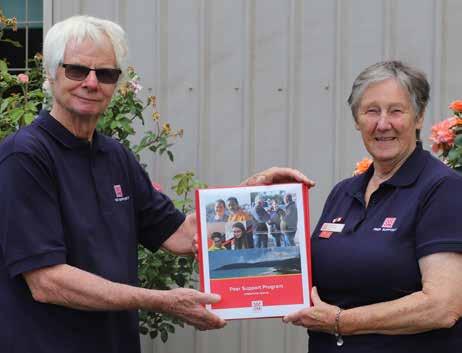
Above: District 13 Peer Coordinator Pat Bigham handing over the new manual to District 13 Peer David Miller
STORY TIM ROGERS
Our new medical provider and medical officer
Based on your feedback asking for a medical provider that has better coverage across Victoria, CFA has appointed a new medical services provider – Injurynet. Injurynet has provided medical services to a range of emergency services organisations including Victoria SES, Ambulance Victoria, NSW Fire Rescue and NSW Rural Fire Service. Injurynet is well-positioned to provide all CFA members with a range of medical services, including physiotherapy and psychology, with more than 350 clinics statewide. The new medical provider will help deliver CFA’s medical programs including vaccinations, medical referrals, preemployment medicals, new volunteer member medicals and the CFA Medical Officer 24/7 on-call triage service. We would also like to introduce the newly-appointed CFA Medical Officer Dr David Milecki. David has more than 30 years’ experience in occupational health and will be supported by an experienced medical advisory team with extensive expertise in public health, infectious disease and occupational medicine. CFA’s Health Services Department seeks to continuously adapt and improve its services to enhance the experiences of members. Its objective is to mitigate illness and injury, promote wellness and optimise the health and safety of our members through the delivery of confidential, fit-for-purpose, effectively coordinated programs. Engaging an appropriate medical provider will help to ensure long-term viability of our programs. Compliance with CFA’s medical programs is essential for maintaining the safety of CFA people while contributing to CFA’s mission of protecting lives and property, and it’s important that you notify CFA through the medical referral program if there’s been a change in your medical condition. For more information about our medical programs go to members.cfa.vic.gov.au/ mycfa/Show?pageId=HealthSurveillance
STORY JOANNE KERR
World Heart Rhythm Week
Cardiac arrests occur when the heart’s electrical system malfunctions and the heart stops beating. This malfunction causes arrhythmias, which can include an increase or decrease in heart rhythm. World Heart Rhythm Week (7-13 June) focuses on raising awareness about the detection of potentially lifethreatening arrhythmias. Find out more by visiting heartrhythmalliance.org/aa/ uk/heart-rhythm-week A simple on-the-go 30-second pulse check could help you identify an irregular heart rhythm. To do this, gently place two fingers on the outer aspect of your opposite wrist. Count the beats for 30 seconds, then double it to get the beats per minute (bpm). On average, this should be between 60 to 100bpm. These beats should be a consistent rate and rhythm the entire time. If you’re concerned you may have an arrhythmia, visit your GP as soon as possible.
Symptoms of arrhythmias
• Chest pain • Fainting • Fatigue • Light-headedness or dizziness • Racing heartbeat • Slow heartbeat • Fluttering or pounding in your chest • Shortness of breath • Sweating Lifestyle risk factors that may increase your risk of developing a heart arrhythmia include: • being overweight • excessive alcohol and caffeine consumption • drug abuse • smoking • stress or anxiety • electrolyte imbalances. CFA Health Services provides confidential cardiovascular health checks with personalised health and lifestyle advice for members. To book a session, email Healthservices@cfa.vic.gov.au. For more information about heart health, visit the Health Services pages on CFA Online: members.cfa.vic.gov. au/mycfa/Show?pageId=Health_ Services For more information on arrhythmias, visit heartfoundation.org.au/ conditions/heart-arrhythmia


The power of the safety share
In early February 2021, an enthusiastic group of District 10 leaders and future leaders gathered at a greyhound racing club in Sale. Despite the strict COVID-19 safety compliance measures, the snaking line moved quite easily through contact tracing details, temperature checks, sanitising and mask issue. After a keynote address by the deputy chief officer, it was time to discuss safety. The aim of the session was to gather ideas and plan for the introduction of a district Health and Safety Committee that will give volunteers a two-way consultative platform to share issues, views and concerns. To begin the discussion the regional health and safety adviser asked for someone in the audience to contribute a safety share. A safety share is a specific health and safety subject at the beginning of a meeting or shift to remind people of the importance of being safe and protecting the environment. District Mechanical Officer Steve O’Shea volunteered to talk about the importance of the road safety legislation, which refers to drivers requiring clear visibility. He noted that when after-market instruments and tools such as navigational devices and dashcams are fitted by brigades onto trucks or vehicle dashboards, they can inadvertently do more harm than good. Steve appealed to the District 10 Leadership Group to consider the procurement and installation of aftermarket products, which he understood were purchased with good intentions but were of concern to DMOs. “When items are mounted on dashboards they can: impede airbag deployment; become missiles in the cabin if an airbag is deployed; become unsecured during a vehicle rollover and cause injury; and can prevent curtain deployment during a burnover,” Steve said. These anecdotal revelations certainly made the audience reflect on their own brigade vehicles and potential hazards of dashmounted accessories. “I will definitely remember the advice from Steve the next time opportunities for funding and brigade purchasing come up,” Golden Beach Captain Paula Grosveld (pictured) said. “The last thing we should do is introduce a hazard where none existed before.” The primary purpose of a safety share is to bring safety to the forefront of conversations and it can also provide an opportunity to demonstrate leadership on safety matters. Safety shares aren’t supposed to be management lectures. They are organic and are based on the experience of the speaker. Anyone can start a meeting with a safety share. It usually includes a key message and a focus on how we can build a better, more proactive health and safety culture in CFA. A safety share can be anything from practical need-to-know information, to recounting a personal experience (from work or elsewhere) and any lessons learned from it. Including personal stories is a very effective way for leaders to communicate and demonstrate how their own values and beliefs are consistent with CFA’s values, and it can positively influence the team’s safety culture. A good safety share should focus on critical messages pertinent to the time and should aim to contribute to a culture that values and reinforces safe people and practices. The HSEW team produces a theme every month to stimulate discussions about health and safety – leaders can use this theme to help their teams’ safety share discussion. See Members Online: members. cfa.vic.gov.au/mycfa/Show?pageId=healthWelfare. Memberdriven local safety shares should also be encouraged from meeting participants. The power of these safety shares is that they show a willingness to share so that others can learn, and they demonstrate a commitment to action which can inspire action in others. This type of leadership has a tremendously positive impact on the safety culture of the team. Is your brigade in the habit of harnessing the power of a safety share? The District 10 event, which focused on safety, was the perfect environment to reflect on the role and purpose of this style of safety conversation starter. Everything you need to know about safety shares can be found in the Safety Share Guideline HSEWGL-005, which is on Members Online.
It’s tough, but think about you for a moment
When a friend says they are in pain or struggling with personal issues we listen, maybe offer some advice and then try to get them some help. Increasingly, through better knowledge and awareness this is also how we would support someone with a developing mental health issue. What’s surprising, however, is evidence suggests that although we are supportive, non-judgemental and caring about the problems and concerns of others, we are not so compassionate when dealing with our own issues and support needs. In short, we tend to be kinder to friends and family than we are to ourselves. The term self-stigma is about an individual’s own internal judgements about mental illness. This can range from thoughts that I will be a burden, to thinking others just won’t understand me or will judge me poorly. This can occur despite there being no evidence of others holding that point of view. We are starting to understand that self-stigma can be a powerful determinant of whether we get the help when we need it – that is, early on when we start to experience an issue with our mental health. Sometimes we can even take the view that this shouldn’t be happening to me and that it indicates a sign of weakness, rather than this is an illness that can be treated. All the things that we are capable of saying to others to be supportive can be the things we simply do not say to ourselves. We know that seeking help early in relation to a developing mental illness is critical to speedy recovery, but stigma can delay or prevent this action, sometimes until a crisis point is reached. If you cut your hand badly or break a leg, you visit a doctor straight away because you know early treatment will get the best results. The same rule applies to a developing mental illness. However, unlike a physical injury, with mental illness there can be a sense of shame, stigma and avoidance associated with getting the necessary support. If you feel you’re struggling with day-to-day challenges, experiencing a low mood for extended periods of time or feel like withdrawing from friends and associates, you may need some support. Sometimes the best approach is to think about what you would say to a friend and then follow that advice yourself. Perhaps think about the conversation you might have with a colleague in a similar situation. Also, think about how supportive you would be if the situation were reversed and your colleague needed help, then talk to someone you trust. If everything is OK, being informed about mental illness is a great step for everyone. This can be as simple as understanding that mental illness can be treated just like any other illness. Also, that getting help for mental health issues involves varied methods and many are about self-help. Challenging the stereotype that mental illness is associated with dangerous and unpredictable behaviour can also help. Keep in mind we are exposed to unrealistic extremes through media and movies. Also, avoid using derogatory or colourful language when discussing mental health. You never know who may hear and be impacted, and the follow-on effect this can have on them dealing with a mental health issue now or in the future. We can find it tough to think about our own needs on occasions, however looking after ourselves is the first step towards ensuring we are able to be there for others. Remember we all have our ups and downs, so reach out for support if you’re going through a difficult stage.
STORY GRAEME BYE

The Health Watch Program has received a makeover. When making a booking, the improved program now offers a menu of session options for brigades to choose from. This helps brigades tailor the session to their needs and interests, including both online and onsite session options. Session options range from healthy eating and developing healthy habits, to group fitness and functional breathing sessions. We still offer our standalone heart health check sessions, though health checks will be delivered differently from this year. Members will have a one-on-one, private 15-minute health check, instead of the original health check circuit. We hope this will reduce the amount of time you have to wait during Health Watch sessions, and provide members with the opportunity to have more time with health check staff to chat about their results. For more information, visit the Health Watch page on Members Online, members.cfa.vic.gov.au/mycfa/ Show?pageId=Healthwatch, or contact healthwatch@cfa.vic. gov.au. You can also check out the Health Watch Facebook page where we share a range of evidence-based health information.
STORY GEORGIA THACKER
Faces of CFA

LEONIE TURNER, HODDLES CREEK FIRE BRIGADE, DISTRICT 13
What is your CFA role? Captain, District 13 peer, Junior leader and catering team member. Why did you join? In 1991 a large fire came close to where we lived and the primary school my boys attended was evacuated. After that I started to think about the people on the trucks and asked others about CFA. With the support of my family I joined a local brigade. What incident has had the greatest impact on you? As a firefighter and peer, the 2009 fires had a significant impact on me. Our strike team turned out in the afternoon and worked through the night. When we were released the following day, we started to hear of the devastating loss of life and property. As a peer, along with many others, I spent time with the brigades, members and their families directly affected by the fires. Who have been your mentors in CFA? Like all captains, a lot of people have given me advice and helped me including current and past captains, group officers, commanders, CFA members and my peer coordinator. At Hoddles Creek the brigade is fortunate to have Rob Worlley. He’s a quiet man with a wealth of knowledge, particularly his bush skills, natural navigation, sixth sense when it comes to reading the weather and the valley winds, which is invaluable for us. What have been the highlights of your time in CFA? High on my list would be the great friendships I have made as a firefighter and a peer. I have the honour to teach and watch the Juniors grow, going on to become valued senior members, Junior leaders and officers in their respective brigades. The Juniors have an abundance of enthusiasm, a have-a-go attitude and a willingness to learn. I’m very proud to be a peer support member and helping other members and their families when required. And being a firefighter helps me to better understand what the brigade or member have been through. The highlights can be as simple as when a person feels comfortable enough with you to tell you honestly how they feel, to helping strike team members when they’re a long way from home. My number one highlight from 2020 was a phone call from North East Region Assistant Chief Fire Officer David Renkin, who told me the brigade would be receiving a new fire station through the CFA capability funding. How do you motivate your brigade members? I hope by just doing my job, having a go, and keeping a positive attitude. Every member has a different skill set, knowledge and ability. When crewing our vehicles, we make sure our newer or younger people are well supported by more experienced members. Mentoring makes new recruits feel welcome, they learn faster and settle into the brigade more quickly. At times, motivating a person can be challenging but keeping a brigade motivated is a team effort. Over the past 12 months we’ve all had to navigate the COVID-19 pandemic. Our Junior brigade face-to-face activities stopped and went online, and our active members only came together when their pagers went off. We all had to learn to embrace Zoom or Teams meetings and training online. I’m lucky to have a great BMT and the officers all stepped up, particularly my 1st Lieutenant Graham Boyd and 3rd Lieutenant Brett Kerford. What lessons are you most keen to pass onto other members? Family first, communication, respect and good teamwork. If you don’t have the support of your family, it would be impossible to be a CFA volunteer. You will never please everyone all the time but if you’re fair, involve your officers in the decisions being made, and keep your members as well informed as you can, everyone is usually happy. Not all people join the brigade to become a firefighter. We have a catering team that does a fantastic job looking after our crews and other emergency services at incidents. Other members help out around the station with the general maintenance and cleaning. No matter what role a member has, respect and teamwork play a huge part. Coming together is a beginning, keeping it together is progress, and working together is success.
When two become one
Two brigades in the Shire of Southern Grampians in District 5, Knebsworth and Byaduk, recently amalgamated following Board approval. The new brigade is called Byaduk and the Knebsworth brigade name has been withdrawn. “The surrounding area is rural and mostly farming community,” Victoria Pullen from the South West Region Volunteer Sustainability team said. “Knebsworth is a very small community and the brigade has been struggling to recruit operational members for some time. “To make matters worse, an ex-captain’s family left the area and the brigade lost two key members. Also, only a couple of members had a truck licence making turnouts more difficult.” Given the small number of brigade members, each person on Knebsworth’s brigade management team (BMT) had to carry out several roles. Former Knebsworth Captain Craig Dettling (pictured on the left with Byaduk brigade Captain Will Kinghorn) said the administrative duties were overwhelming the brigade. “The workload was being done by fewer and fewer people, and they got burnt out and didn’t want to do it,” Craig said. “Also, organising an event for a handful of community members takes just as much time as it does for a larger community, so having a larger brigade means things are easier to organise and there’s less pressure on members.” The brigade knew it couldn’t continue in the same way. The catchment team looked at the viability of the Macarthur Group, which Knebsworth brigade belongs to, and found that several brigades had viability issues. A proposal was made to amalgamate Knebsworth and Byaduk. The team met with the brigades to explain the process and support the assistant chief fire officer who wrote an endorsement paper. In 2019, Victoria was tasked with progressing the amalgamation. “It was important for the brigades and local community to make decisions for themselves,” Victoria said, “and work out the best options for the group. The challenge moving forward will be to support the new brigade members to work cohesively as one.” The Knebsworth Fire Station (pictured below) will retain its name and will be a satellite station to the Byaduk brigade, with a tanker remaining at the station. “One of the most important things for our community was that we kept a tanker here,” Craig said. “It’s valuable to have a quick response.” Will Kinghorn could see other benefits to the amalgamation. “In a small brigade it’s hard for the training officer to do any meaningful training. With a brigade like ours, even if only half the members turn up for training it’s still worth doing. But at Knebsworth if that happened only one or two would turn up. “Also, with a larger core group we can have a truck testing roster to share the load.” Original Byaduk members who live closer to Knebsworth will turn out on the Knebsworth satellite station truck. “In the past we’ve supplied drivers to Knebsworth and helped man their truck,” Will said, “so the amalgamation is just formalising that.” The BMT elections for Byaduk brigade were held on 1 March 2021 and Will was re-elected as the captain. Three former Knebsworth officers were elected into BMT roles, including Craig as 1st lieutenant.

PHOTO: TRACY CHAPMAN

The Chief tours the regions
1
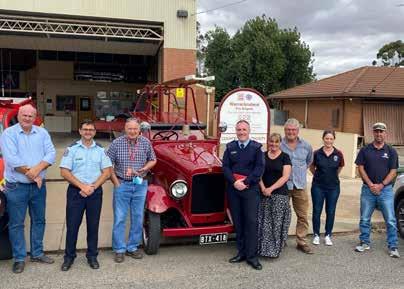

Meeting CFA volunteers has been a top priority for CFA Chief Officer Jason Heffernan since he started on 30 November 2020. During his first month in the job, he met members across the organisation and kicked off a regional tour in North West Region in December. Over four days in mid-December, Jason visited brigades and district headquarters in Bridgewater, Ouyen, Mildura, Swan Hill, Kerang, Echuca, Bendigo and Melton. In Ouyen, he met group officers and captains to listen to the challenges of fire service delivery in remote and rural communities. In Swan Hill, he met staff, captains and group officers from District 18. In Echuca, he listened to and shared in the experiences of upcoming CFA leaders who recently completed the CFA Mentoring Program. Jason said it was great to meet with CFA volunteers in particular, whose passion and commitment are second to none, and hear their thoughts on the organisation’s challenges, opportunities and areas for improvement. “It was a pleasure to travel around the north-west, meeting some of our incredible members and receiving a warm welcome to our organisation,” Jason said. In early January, he toured West Region, making stops at Horsham, Ararat and Wendouree, visited the new station site at Dimboola, and met with captains, group officers and other volunteer members from brigades including Warracknabeal, Stawell, St Arnaud, Beaufort, Willaura, Daylesford, Blackwood and Ballarat. “At St Arnaud brigade, our volunteer members raised with me the importance of diversity and the role it plays in the longevity and capability of CFA, which I strongly agree with,” Jason said. At the end of January Jason toured South West Region over three days. He visited volunteers and staff at Portarlington, Winchelsea, Lismore, Koroit, Heywood, Casterton, Cobden and the Hamilton Air Base which is run entirely by CFA volunteers. “It is grounding for a chief officer to be among our members to listen to what matters most and share in their experiences,” Jason said. “In the south-west I discussed the importance of roadside vegetation management, safety, and the role of private farm fire units in rural areas,” Jason said.



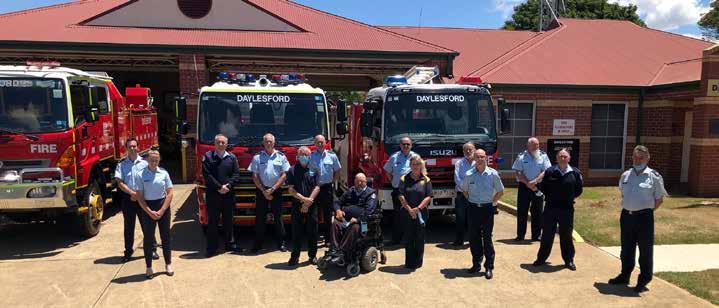
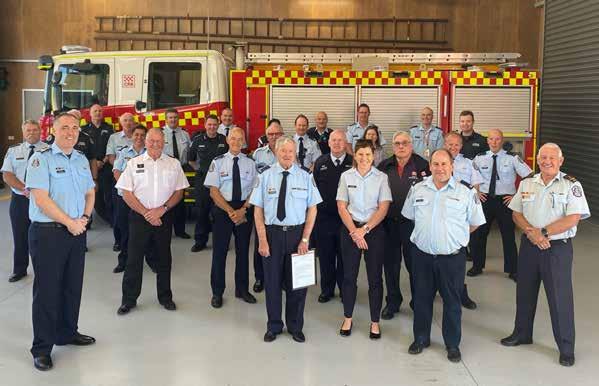
5
6
71 Beaufort 2 Ouyen 3 Wannon Falls 4 Warracknabeal 5 Swan Hill 6 Daylesford 7 District 7 Headquarters
The Volunteer Recruitment and Retention Project team is developing a wide range of initiatives to support brigades with the crucially important tasks of recruitment and retention. Some of these initiatives will result in new and innovative resources, while others are new online versions of paper-based resources or expansions of existing online resources.
Stories by Niki Habibis
case study
Thank You Day for Leigh Group
The commander and BASO for Leigh Group in District 7 wanted a way to say thank you to their CFA members. They believed that local brigades were suffering because of rural decline, yet still had to try to recruit new members and engage existing ones. The catchment team reached out to local companies to help fundraise for a ‘Thank You Day’. They received $5,000 from the local wind farm company which allowed them to book a venue and hold a free barbecue to thank members and their families for their dedication to the brigades. This included food, drinks, activities and games for children, music and various stalls. Local community groups were also invited to participate. Members and their families felt appreciated for their dedication to CFA and also felt connected to their community. It was a very positive day for CFA. It not only promoted CFA’s activities and encouraged people to get involved, but also strengthened relationships between CFA members and other community organisations.
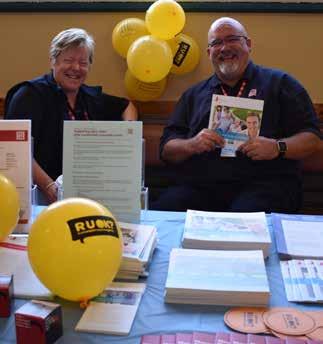
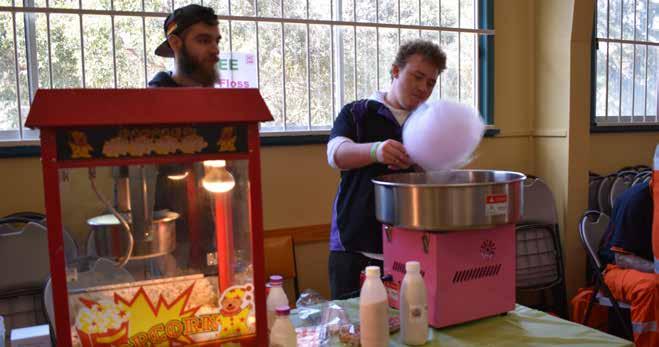
Volunteer Onboarding Platform
The Volunteer Onboarding Platform (VOP) is one of the most exciting developments we’re working on in the Volunteer Recruitment and Retention Project. In a nutshell, it’s a new purpose-built online platform comprising two components: • The redevelopment of the existing online new member expression of interest (EOI) platform, including an enhanced admin dashboard to help manage new EOIs. • A new online member registration system that replaces the current paper-based registration process. The team has been working closely with regions, VFBV and directorates to plan, scope and develop the VOP so that it meets the needs of brigades. “Anything we develop must have our end user in mind, and in this case it’s both members of our local communities who want to join CFA and our brigades who are onboarding new members,” Project Manager of the Volunteer Recruitment and Retention Project Niki Habibis said. “Joining CFA is a positive experience and our systems must support that.” The first phase of the EOI platform redevelopment went live in December 2020, and since its launch there have been more than 900 applications submitted through the new system. Phase 2 was released at the end of March. This phase will give brigades access to an EOI dashboard and the ability to oversee and manage new applications for their brigade. It’s important to note that the introduction of the VOP doesn’t change the way brigades manage and oversee their recruitment – local recruitment processes remain in place. The VOP is designed to help streamline the administrative components of onboarding new volunteers, with support staff always here to help. Some of the exciting enhancements for the EOI platform are: • Address search capability. New applicants can select a brigade based on either their home, work, or ‘other’ address allowing great flexibility. • Built-in mapping to identify the closest brigade(s) based on an address, making it easier to connect new potential members to brigades – including those in Fire Rescue Victoria areas. • A brigade assessment process to inform decision making around new member applications. • Brigades can set their recruiting status for both operational and non-operational roles, as well as activate a wait list. • Brigades will have oversight of the status of new member EOIs. • New members expressing interest can check the status of their application, leading to a reduction in multiple EOIs being submitted. “The successful recruitment and onboarding of new members is integral to brigade management and the VOP will help make this easier for brigades,” Niki said. The project team has developed a range of resources, including FAQs, user manual, demonstration videos and quick reference guides to help members understand and navigate the EOI system and dashboard. These can be found on the Volunteer Recruitment and Retention Project page on Members Online. Work has already begun on building the next stage of the VOP – the online registration component. We anticipate this will take time to complete because of the complexities of new member registration, but it’s important we get it right. To keep up to date with the progress of the VOP, check out Members Online: members.cfa.vic.gov.au/mycfa/ Show?pageId=recruitRetainProject. If you have any questions about VOP email vopmailbox@cfa.vic.gov.au.
Flexible volunteering
The aim of the Flexible Volunteering project is to develop a model of volunteering that’s adaptable to suit brigades across the state and will allow members of the community to volunteer with CFA in new ways. The first step of the project is to engage with our members to understand the challenges they face with the current membership model as well as identify any possible solutions and lessons learned from previous experiences. This will be conducted through regional workshops, where key volunteers and staff who manage membership will be invited to attend, and through an online survey which all members can access. It’s imperative we engage with field-based staff and volunteers throughout the project, because their feedback and ideas will shape the flexible volunteering model we develop. While gathering evidence from our members, research will be carried out into existing models in other emergency services agencies which could be adopted by CFA. A project management plan will be produced to identify key outputs and outcomes, with the aim to implement a pilot in the 2021-22 financial year. To submit your thoughts, insights or experiences please visit the Flexible Volunteering Your Say CFA page: yoursay.cfa.vic.gov. au/flexible-volunteering.
Information for Families resource
We all know that volunteers play a crucial role in CFA, but many volunteers say they couldn’t do it without the support of their families. To recognise the importance of the support, patience and encouragement of their families, CFA has recently launched the Information for Families resource aimed at families and caregivers of new CFA volunteers. The family member may not be holding a hose or conducting a community engagement session, but they are very much a part of our CFA community and play a very important role in brigades. Information for Families gives family members tailored information about the activities and time commitments of CFA volunteering. It includes sections on what to expect when the pager goes off, information about preparing a home fire safety plan, keeping up to date with community messaging and accessing wellbeing support for themselves or their family member. Existing members can access an online version which can be passed onto families. It’s on the CFA website here: cfa.vic.gov.au/ volunteer-careers/volunteers/information-for-families. New members will receive a hard copy booklet with their ‘Welcome to CFA’ letter. This booklet should be passed onto family members, who can then access the online resources by using the QR code or website link. If you’ve recently joined CFA and haven’t received your booklet, request one from your district headquarters. We hope volunteers’ families think the guide is a useful resource that helps them understand the important role they play in the CFA community.
Knowledge Sharing Platform
The Knowledge Sharing Platform (KSP) has been expanded to include a wider range of topics covering situations members will experience during their time as a volunteer. There are now 23 themes including recognition, health and wellbeing, partnerships, technology and social media, engaging diverse communities, fundraising, mentoring and succession planning. Sharing knowledge stimulates innovation and growth and can help brigades find inspiration for activities or overcome issues they may be facing. The KSP can be accessed through Members Online: members.cfa. vic.gov.au/mycfa/Show?pageId=KnowledgeSharingPlatform The recruitment and retention tips, right, can be found on the KSP.
Volunteer Toolkit
The Volunteer Toolkit has transitioned from a paper-based guide to an online toolkit. It contains new and updated resources and templates to support the various stages of a volunteer’s life cycle, from attraction to the brigade, their time as a member, through to exiting the brigade. Check out the resources in the Volunteer Toolkit on Members Online: members.cfa.vic.gov.au/mycfa/Show?pageId=volHome.
Brigade recruitment and retention tips
Recruitment tip 1: Recruitment officer Creating a recruitment officer role will give potential new members a direct contact in the brigade who can share specific information and answer any questions about joining. The recruitment officer can introduce new recruits to the brigade and support them as they settle in. Recruitment tip 2: Community information day Hosting a community information day is an effective way to educate the community about fire safety, talk about the brigade and what the brigade does, while also recruiting new members. Rowsley Fire Brigade advertised extensively and held a successful community information day which resulted in three new members.
Recruitment tip 3: Juniors to seniors An effective way to recruit is transitioning Junior members into the senior brigade when they are old enough. Kiewa Fire Brigade demonstrated the importance of having a close relationship between the two by introducing 16-yearold Juniors to the seniors and allowing them to watch their training. This led to recruiting three Juniors into seniors. Retention tip 1: Keep members active Briagolong brigade illustrated how even a brigade that has only around 50 callouts a year can retain 56 members by engaging them through methods other than turning out for fires. Offering a variety of activities for members to participate in is an effective way to maintain member involvement. Retention tip 2: Appreciate members and their families Hosting an event to recognise the role of members and their families allows brigades to show their appreciation for the time and effort people dedicate to CFA. Leigh Group, featured on page 56, held a barbecue for its members and invited local community groups to participate, which meant members felt valued by and connected to their community. Retention tip 3: Recognition through social media Social media can be used to recognise members’ hard work and to promote the brigade within the community and deliver fire safety messages. This can allow members to feel valued and increase retention in the brigade. A good example of this is Horsham Fire Brigade’s ‘Horsham Hotshots’ posts on its Facebook page. Regional Brigade Administration Support Officer and Brigade Member Sue Martin said Horsham brigade wanted a way to recognise members for their hard work. “A short post is made once a week. It’s dedicated to members, introducing them and giving information about their role in CFA,” Sue said. “The posts acknowledge members for any significant efforts they have made. For example, if they have recently received an award or praise. “It has been a great positive form of recognition for brigade members and helps the community understand more about CFA and its people. It has also helped to build Horsham brigade’s social media presence and reach more of the community. “It provides a more personal approach and delivers community safety messages to members of the community.”




